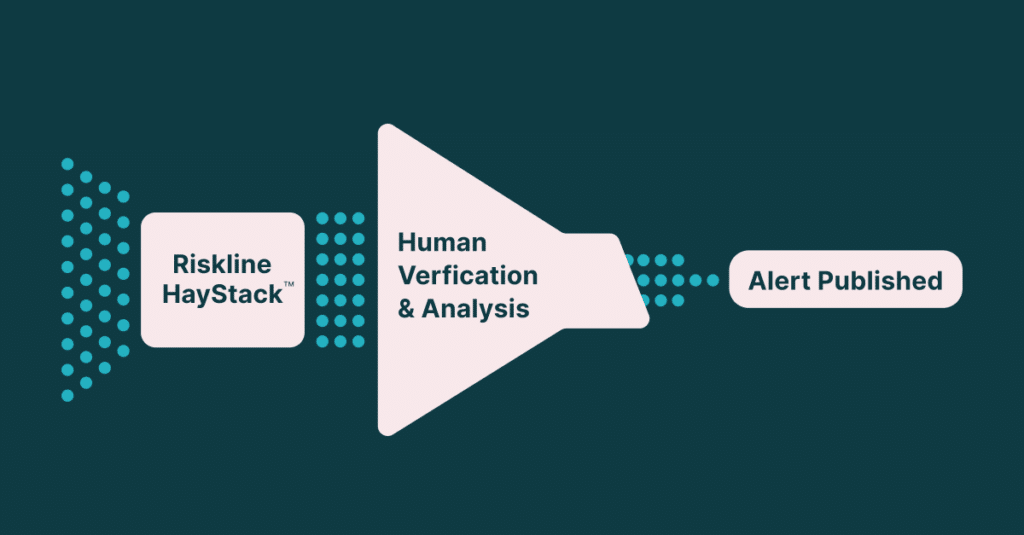With contributions by Adam Schrader, Nikita Billier, Patricia Baruffi and Samir Brahimi
At Riskline, delivering accurate and up-to-date travel risk intelligence is at the heart of what we do. We rely on a diverse range of open-source intelligence (OSINT) to track planned events and unfolding crises. This includes international and local media outlets, social media platforms, digital maps, government agencies and specialised sources like disaster relief organisations and weather services.
Why is having updated information so crucial? The numbers speak for themselves. According to TravelPerk, 79% of global business travellers have experienced travel disruptions. Real-time alerts help businesses stay ahead of these disruptions, enabling quick decision-making when situations change rapidly. At Riskline, we issue over 700 alerts per week to keep travellers informed and prepared.
From social media to satellites: The diverse sources powering our analysis
We gather information from over 100,000 sources, including:
- Social media platforms like X, Facebook, Instagram and Telegram for immediate updates on breaking news, disruptions or on-the-ground developments.
- Official statements from local police, emergency services and government authorities.
- News outlets, including international and local media.
- Academic studies and crowdsourcing tools like OpenStreetMap and Waze for real-time insights on road closures and disruptions.
To verify this information, we employ OSINT techniques, cross-referencing independent sources to evaluate their reliability and credibility. We also assess how the information aligns with established facts and timelines. In regions where information is limited, particularly in areas affected by conflicts, we supplement our analysis with satellite imagery and data from NGOs and humanitarian organisations.
To bring it all together, we developed our proprietary platform Haystack, used to collect and process information from open sources. It was designed to cut through the noise, filtering out irrelevant or unreliable information before it reaches our analysts.This ensures that only the most relevant updates are considered for coverage, from military coups to flight disruptions.
Spotting disruptions before they happen
Anticipating disruptions is a key part of our work. We monitor protest groups, movements and disruptions that might affect travel by:
- Analysing historical data to identify patterns in regions prone to unrest.
- Monitoring public platforms and communication channels used by protest and activist movements.
- Monitoring news outlets and social media for emerging developments that could impact travel.
While our Alerts provide real-time updates on ongoing incidents, our Notices focus on events that are coming up in the future, such as demonstrations, elections or major protests. We send these out as soon as dates are announced, which can be even a few months in advance, giving enough time to create alternative plans.
How we conduct multilingual research
With a global reach, multilingual research is critical to the accuracy and depth of our analysis. Our analysts access and interpret information in local languages, capturing nuanced details.
Our team is proficient in 18 languages, such as French, Greek, Russian, Turkish, Korean, Kazakh, German, Hindi, Indonesian, Italian, Portuguese, Spanish and more. Spread across the globe, our analysts are often located where the news is happening, bringing not only linguistic expertise but also deep regional knowledge and cultural understanding. This unique positioning enables them to navigate and contextualise complex local dynamics.
Delivering trusted intelligence
The verification process is carried out by our team of analysts, who are trained in OSINT techniques and skilled at identifying fake news, misinformation and disinformation.
Before any alert is sent out, we follow a rigorous verification process. Rather than relying on a single source, we cross-check information across multiple trusted channels. This could include official websites, meteorological agencies or reputable local news outlets.
In addition to this, we have an added layer of verification: every alert is reviewed by a second analyst before it is published. This ensures a two-factor verification process, providing an extra level of accuracy and reliability. For urgent events like natural disasters or crises, we set up dedicated internal channels of communication to receive constant updates and adapt quickly as new details emerge.
Our tools help us stay informed and responsive. We use platforms like Telegram, X and RSS feeds to track updates and we tailor our searches to focus on relevant topics. For example, we might set up alerts specifically for a region or type of event, like wildfires in California or floods in the UK, and then monitor these sources more closely during a crisis. These tools are set to scan for new information every few minutes and our analysts manually check these updates to ensure everything is relevant.
We also regularly review our sources to make sure they remain reliable and up-to-date. We have a flexible approach, constantly adapting to ensure that we’re using the best sources for the job.
By staying diligent with how we select, verify and manage our sources, we make sure our alerts are as accurate and helpful as possible. This process allows us to deliver timely information to help businesses navigate travel risks safely and effectively.
